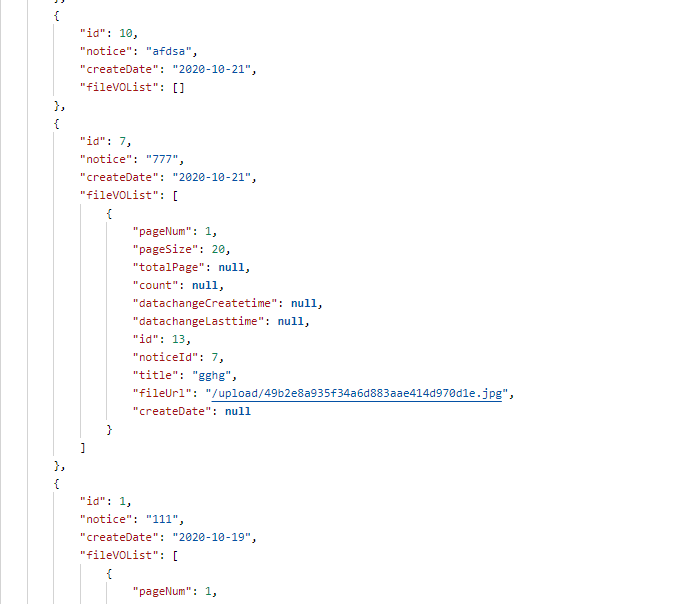使用Mybatis分页插件[PageHelper]处理一对多关系
闲聊:这种问题基本上都比较常见,以前遇到这个问题的时候总是故意绕弯来避免,后来经过我一天的百度浏览,终于懂了,搜索百度,我们会看到很多关于这个问题的解决方案,基本上都是说使用resultMap的子查询方法,经过我亲身实验,确实有用,但是很多博客解决方案是提出来了,但思路不够具体,只是草草的说了几句,比如,使用resultMap子查询来解决,具体的解决方法应该是啥,我之前从来没用过resultMap的子查询,搞了半天也没弄明白,后来终于看到一个有用的博客了,现在我就来更具体的给大家分享这个解决方案
1.resultMap
首先给大家更具体的介绍一下resultMap里面的包含的元素以及词义:
<!--column不做限制,可以为任意表的字段,而property须为type 定义的pojo属性--> <resultMap id="唯一的标识" type="映射的pojo对象"> <id column="表的主键字段,或者可以为查询语句中的别名字段" jdbcType="字段类型" property="映射pojo对象的主键属性" /> <result column="表的一个字段(可以为任意表的一个字段)" jdbcType="字段类型" property="映射到pojo对象的一个属性(须为type定义的pojo对象中的一个属 性)"/> <association property="pojo的一个对象属性" javaType="pojo关联的pojo对象"> <id column="关联pojo对象对应表的主键字段" jdbcType="字段类型" property="关联pojo对象的主席属性"/> <result column="任意表的字段" jdbcType="字段类型" property="关联pojo对象的属性"/> </association> <!-- 集合中的property须为oftype定义的pojo对象的属性--> <collection property="pojo的集合属性" ofType="集合中的pojo对象"> <id column="集合中pojo对象对应的表的主键字段" jdbcType="字段类型" property="集合中pojo对象的主键属性" /> <result column="可以为任意表的字段" jdbcType="字段类型" property="集合中的pojo对象的属性" /> </collection> </resultMap> <strong>如果collection标签是使用嵌套查询,格式如下:</strong> <collection column="传递给嵌套查询语句的字段参数" property="pojo对象中集合属性" ofType="集合属性中的pojo对象" select="嵌套的查询语句" > </collection>
好了,理解了以上各元素的意思后,开始写代码了【注意:这里只写子查询哦!】
2.创建两个存在父子关系的表和类
【这里就不写在数据库的创表数据了】
- 主表字段信息:
@Data
public class TbNoticeVO extends BaseVo {
@ApiModelProperty(value = "自增主键")
private Long id;
@ApiModelProperty(value = "公告内容")
private String notice;
@ApiModelProperty(value = "创建时间")
private java.time.LocalDateTime createDate;
@ApiModelProperty(value = "修改时间")
private java.time.LocalDateTime modifyDate;
}
- 子表字段信息:
@Data
public class TbNoticeFileVO extends BaseVo {
@ApiModelProperty(value = "自增主键")
private Long id;
@ApiModelProperty(value = "公告表id")
private Long noticeId;
@ApiModelProperty(value = "标题")
private String title;
@ApiModelProperty(value = "文件上传路径url")
private String fileUrl;
@ApiModelProperty(value = "创建时间")
private java.time.LocalDateTime createDate;
}
因为要关联两张表一起查询,所以在此,我们可以创建一个bo类
@Data
public class TbNoticeBO implements Serializable {
private static final Long serialVersionUID = 1L;
@ApiModelProperty(value = "自增主键")
private Long id;
@ApiModelProperty(value = "公告内容")
private String notice;
@ApiModelProperty(value = "创建时间")
@DateTimeFormat(pattern = "yyyy-MM-dd")
private java.time.LocalDate createDate;
private List<TbNoticeFileVO> fileVOList;
}
3.mapper层接口
public interface TbNoticeMapper {
List<TbNoticeBO> getNoticeFile(TbNotice model);
}
4.service层接口
public interface ITbNoticeService {
Page groupbypage(TbNoticeVO model);
}
5.serviceImpl服务实现层
@Service
public class TbNoticeService extends AbstractBaseService implements ITbNoticeService {
@Autowired
private TbNoticeMapper tbNoticeMapper;
@Autowired
private TbNoticeFileMapper tbNoticeFileMapper;
@Override
public Page groupbypage(TbNoticeVO model) {
TbNotice param = copyProperties(model, TbNotice.class);
PageHelper.startPage(model.getPageNum(), model.getPageSize());
List<TbNoticeBO> list = tbNoticeMapper.getNoticeFile(param);
PageInfo pageInfo = new PageInfo(list);
return new Page(pageInfo.getPageNum(), pageInfo.getPageSize(), pageInfo.getNavigateLastPage(), pageInfo.getTotal(), list);
}
}
6.mapping映射文件
<!--公告通知表的resultMap映射-->
<resultMap id="getGroupByList" type="com.bestva.service.bestvascm.entity.bo.TbNoticeBO">
<id property="id" column="id"></id>
<result property="notice" column="notice"></result>
<result property="createDate" column="create_date"></result>
<collection property="fileVOList" ofType="com.bestva.service.bestvascm.entity.vo.TbNoticeFileVO"
javaType="java.util.List" column="{noticeId=id}" select="getByNoticeId">
</collection>
</resultMap>
<select id="getNoticeFile" resultMap="getGroupByList"
parameterType="com.bestva.service.bestvascm.entity.dto.TbNotice">
select n.id,n.notice,n.create_date
from tb_notice n
where 1=1
<if test="id != null">
n.id=#{id}
</if>
ORDER BY create_date DESC
</select>
<resultMap id="NoticeFileResultMap" type="com.bestva.service.bestvascm.entity.vo.TbNoticeFileVO">
<id property="id" column="id"></id>
<result property="noticeId" column="notice_id"></result>
<result property="title" column="title"></result>
<result property="fileUrl" column="file_url"></result>
<result property="createDate" column="create_date"></result>
</resultMap>
<select id="getByNoticeId" resultMap="NoticeFileResultMap">
select f.id,f.notice_id,f.title,f.file_url
from tb_notice_file f
where f.notice_id=#{noticeId}
</select>
7.子查询详解【图片版】

8.Cotroller返回json数据
@PostMapping("/tbNotice/groupbypage")
@AutoLog(description = "分页查询公告通知信息接口")
@ApiOperation(value = "分页查询公告通知信息接口")
public BaseResponse<List<TbNoticeBO>> groupByPage(@RequestBody TbNoticeVO request) {
return new BaseResponse(true, "查询成功", 0, tbNoticeService.groupbypage(request));
}
使用postMam得出的json数据

--我是一只在深圳打拼的蜗牛,一起加油吧!
未经允许不可转载哦!


